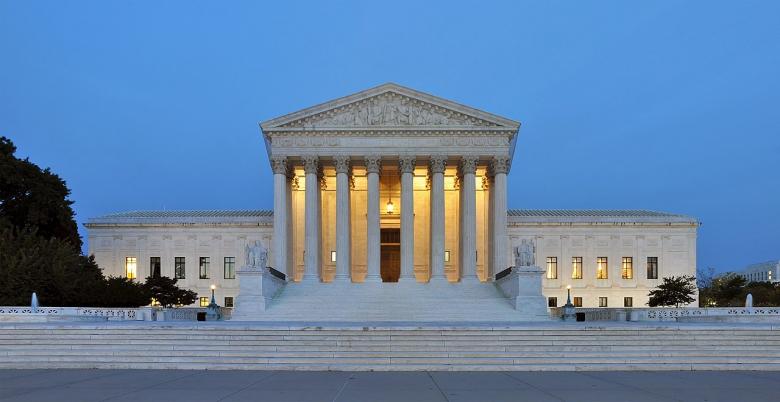14. 6月 2023
United States Supreme Court Building, Cass Gilbert, 1935 (Photo: Joe Ravi/Wikimedia Commons/CC-BY-SA 3.0)
Florida Senator Marco Rubio has introduced the ‘‘Beautifying Federal Civic Architecture Act,’’ which would effectively resurrect former US President Donald Trump's revoked executive order mandating classical styles for federal buildings.
Republicans are a tenacious lot, seemingly never deterred by defeat. Can't get something done one way? Pivot and try another way. Was that executive order, no matter how questionable, revoked by the incoming administration? Put it together as a bill in the Senate, with a companion bill in the House of Representatives, and try to make it into a more lasting, permanent law. This is just what is happening with former President Donald J. Trump's "Executive Order on Promoting Beautiful Federal Civic Architecture," which he signed in December 2020 as one of his last acts as president. It was promptly revoked in February 2021 by President Joseph R. Biden and yesterday, following two years of silence on the issue, Marco Rubio and a handful of Republican Senators introduced the “Beautifying Federal Civil Architecture Act.” Over at the House of Representatives, Indiana Congressman Jim Banks and a laundry list of Trump devotees (Marjorie Taylor Greene, Matt Gaetz, Paul Gosar, Clay Higgins) introduced a companion legislation with the same name.
What do the bills strive to mandate? The same thing Trump's executive order did: “make classical and traditional architecture the preferred architectural style for certain federal public buildings.” The “certain” includes federal courthouses and federal headquarters, any federal building in Washington, DC, and any public building outside of DC (minus infrastructure and ports of entry) costing more than $50 million in 2023 dollars. The bills would also, through the establishment of a “Council on Improving Federal Civic Architecture,” work to change the policies of the General Services Administration (GSA), the body that oversees the creation and maintenance of the federal government's buildings, so it adheres to the bill’s requirements. With Trump's executive order and the proposed bills, the GSA has been singled out as the culprit for federal buildings looking modern, a style apparently out of step with the preferences of most Americans. The last point leads to another part of the bill: requiring public input before the selection of an architect or the determination of a style — Neoclassical, Georgian, Federal, Greek Revival, Beaux-Arts, Art Deco … anything but Modern — for an applicable federal building.
Quibbles over modern vs. classical find justification in a 2020 Harris Poll that determined “7 in 10 Americans (72%) [prefer] a traditional look” for US courthouses or federal buildings. Setting aside the methodology of the poll, which simply asked “this vs. that” in pairs of photographs of buildings (architects may promote themselves through photos, but they know their buildings are much deeper than that), it's worth noting that the poll was put together by a nonprofit organization, the National Civic Art Society, whose president, Justin Shubow, was appointed to the Commission of Fine Arts by Trump and most likely authored the December 2020 executive order; at the very least, he indirectly authored the newly introduced bills, which seem to copy/paste the text directly from the executive order. Not surprisingly, Rubio's press release has an endorsement from Shubow, while one at the National Civic Art Society “hails” the “much-needed bicameral legislation.”
Congressman Jim Banks, in an op-ed about his bill, cites that same poll, though he takes the results in a somewhat comical (unintentionally, I'd wager) direction. “At a time when Americans are divided about so much, one thing that unites us, regardless of race, sex or class,” he writes, “is the preference for classical architecture over modern architecture.” Really, Jim?! Maybe most Americans' tastes do veer in that direction, but their interest in architecture is so low it is hardly a subject that can be seen to unite a divided nation. If it were, wouldn't architecture be a bigger topic for discussion, otherwise? It's very easy to find other also-majority poll results that relate to subjects more important to Americans, such as gun control (“Six in 10 Americans support stricter gun laws”) and abortion access (“About six-in-ten Americans say abortion should be legal in all or most cases”), but it's obvious why Republicans don't side with the majority there. Instead, architecture is being used as fodder for ongoing, unnecessary culture wars. “Despite how divided we are as a nation,” Banks concludes in his op-ed, “building beautiful buildings is a goal that nearly all Americans find worth pursuing.” Hardly.
関連した記事
-
A Short-Lived Architectural Prescription
on 2024/09/22
-
The Style Wars Resume
on 2023/06/14
-
Biden Shakes up Commission of Fine Arts
on 2021/05/26
